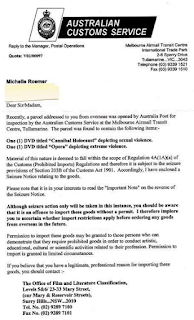Hell's Coming for You (2023, dir. Mark Savage, USA)
A family
is enjoying a relaxing day at a picturesque lake, up until the extraordinary sight of a
car driving across the lake which is soon to shatter the peaceful
serenity. The vehicle, transporting two men, heads straight towards the family
- who assume it is a custom-designed boat. Without a word, the men,
brandishing machine guns, wipe out mom, dad, and daughter. The young son, Liam Hell, however, miraculously survives the massacre.
Although paralysed from the waist down and therefore confined to a wheelchair,
Liam (Dillion Dilligaf) spends the next few
decades climbing the ranks to become one of the world’s most successful, prolific – and
notorious – bounty hunters. Fast-forward to the retirement party Liam is
hosting at his new home in a quiet suburban community, at which a ragtag group
of associates are attending, including his best friend and
right-hand man Eddie (Tim Chizmar). Liam’s plans for
a sedate lifestyle are about to be completely upturned by a series of
shockingly unexpected events. When his beautiful neighbour Amanda (Tonya Todd) drops by to introduce
herself, Liam susses out that the unfortunate woman is being terribly abused by
her brutish partner Bruce (Samuel L. Culver). Amanda hints that she wouldn’t
miss Bruce if he were to suddenly disappear, and as the pair have had an
immediate attraction, Liam takes note of this. At the same time, Liam is
reminded of the tragic murder of his wife several years back when he receives a
mysterious phone call from someone claiming they were not only there when she
died, but that he was the one that was meant to be killed. Furthermore, those
who plotted his would-be demise are much closer to home than he realised. With
Bruce and the gang who had it in for him on his hit list, Liam roams the vast desert
landscape of Nevada with Eddie, armed with an eclectic arsenal of weaponry and
his mind on literally and figuratively bloody vengeance.
Australian-born indie-horror/cult dynamo Mark Savage has consistently
proven himself to be a formidable talent since his 1986 feature-length
debut Marauders, and continues on this path with Hell’s Coming for You, his best work since his
2017 masterpiece Purgatory Road. As always with Savage’s output,
the film looks great, its slick, polished glossy sheen, punctuated with
stunning aerial cinematography and both sun-drenched and vivid primary-coloured
bursts of lighting belying its limited budget. Scenes of violence are
orchestrated like elegant set-pieces – utilising fluid camerawork, slow-motion
and a throbbing synthesiser score to great effect. Such moments of bloodshed
are well-paced with character and plot development. The trio of principal
actors (Dillion Dilligaf, Tim Chizmar and Tonya Todd) are likable,
endearing and hold up well in their performances; Dilligaf and Chizmar, who
also co-wrote the screenplay with Savage, are fun “odd couple” buddies, and
Todd is sympathetic as the long-suffering Amanda. Dilligaf, a successful
stand-up comedian, is particularly effective in his leading role debut as
incapacitated marksman Liam Hell, veering between the extremes of his calm,
slow-paced life surrounded by middle-class suburban “normies”, and the
ruthlessly violent contract killer underworld with its lawless denizens. Some
critics view some of the acting and dialogue delivery as shortcomings in
Savage’s films, however these are not intended to be realistic personalities.
They are larger-than-life, comic-book type characters, worlds where expressions
may be more understated or overstated than “in real life” (note the graphic-novel
like promotional artwork for Hell’s Coming for You) and should be
viewed as such. Some plot elements are never fully explained, but that is the
beauty of Mark Savage’s films – these elements are open to the viewer to
interpret and speculate, as part of the cinematic spectacle. In the universe of
Savage’s Sinema, everything isn’t spelled out in words of one syllable to the
audience, thus viewers are often polarised by his work. Personally, I love the
off-kilter, carnivalesque nature of Savage’s filmography, punctuated with
welcome moments of surrealism and carnage, and Hell’s Coming for You is
an immensely entertaining winner from this uncompromisingly unique
filmmaker.




























